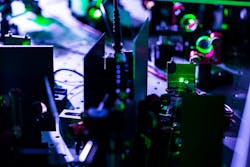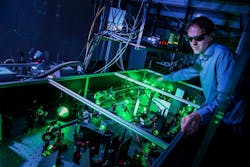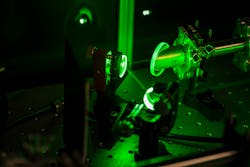High-harmonic generation: A tutorial with Stefan Witte
Laser Focus World: What is high-harmonic generation?
Stefan Witte: High-harmonic generation is an extremely nonlinear process to create very short wavelengths—extreme ultraviolet (EUV) through to soft x-ray—via high-power ultrafast lasers.
Researchers can use this small-scale tool within a lab and do experiments with it—typically not at the same level as an x-ray free-electron system in terms of flux—in a flexible and accessible way. If high-harmonic systems give you enough pulse energy/photons to do your thing, it provides an alternative way to generate short wavelength radiation, coherence, or to do time-resolved experiments.
Perhaps the most surprising aspect of high-harmonic generation is that it’s coherent. It uses a very intense ultrafast laser pulse focused within a gas, where the electric field of the light becomes stronger than the field that binds the electrons to an atom, so electrons get ripped out and accelerated, then come back and all the kinetic energy they picked up gets released in the form of photons. This is a rapid electron acceleration on attosecond timescales and out comes this coherent beam of radiation with a well-defined phase front that can be linked to the front of the driving laser. Everything in the harmonic beam has very controlled properties: timing, phases, wavelengths.
Although the underlying process is violent and high-intensity, it’s almost a paradox it works this way. As a physicist, if you think about it a bit, it all makes sense. But honestly, it still surprises me a bit every now and then.LFW: What kind of lab setup is involved in high-harmonic generation?
Witte: It usually involves an optical lab containing a high-power ultrafast laser, which is the key component. You need an ultrafast laser to produce femtosecond pulses—shorter is better—with pulse energies of an order of magnitude of at least millijoules. You can then focus these laser pulses down into a gas medium, which is typically inside a larger vacuum chamber where a jet or cell contains the gas that acts as your nonlinear medium. This is where the magic happens.
LFW: Can you buy what you need for high-harmonic generation or do you need to build it?
Witte: A few companies now sell complete ready-to-go harmonic generation systems, but this is a new development. These systems are engineered to the point where you can basically buy the entire system and produce harmonics from equipment already on your table.
Some teams still prefer to build systems themselves, including us, because we think we can do a little better if we tailor the pulses to how we like them.
Gas cell/vacuum systems are where most of the specialty work comes in. Typically, you want to use the radiation being produced for an experiment, so the extreme ultraviolet wavelengths need to travel through a vacuum (otherwise air absorbs it). The radiation is produced within a little gas cell, which is typically argon, neon, or another noble gas. Its interaction happens within about a millimeter to a centimeter of gas that is localized inside a vacuum system, which allows the light you generate to propagate undisturbed.Then it needs to be sent to your experiment, which is imaging in our case, but it can be attosecond science, atomic physics, or whatever you want. You’ll need a dedicated experimental apparatus for your specific research connected to it, and to design the whole thing in ‘one go’ to ensure you have the light you generated at the location you want, with the right properties, focusing or not, etc. Typically, researchers build this part themselves.
There’s a bit of design work involved because the radiation is so sensitive—it’s absorbed by almost everything and requires a vacuum. Focusing must be done with reflective components like mirrors, because lenses don’t really exist at these wavelengths and every material tends to absorb quite rapidly. It’s important to figure out how to get this radiation to your experiment so it does what you want it to do.
LFW: How is high-harmonic generation evolving?
Witte: High-harmonic generation was first conceived during the early 1990s, so it’s been around a while, but conceptually it’s remained the same. The first experiments were done with a high-power laser focused into a gas inside a vacuum chamber, which is still the case. The main thing is that the lasers improved, which is what really drives technology and makes new experiments possible.
In the first experiments in the 1990s, picosecond lasers were state of the art and repetition rates were 10 pulses/second. Right now, it’s standard to have lasers with pulse durations below 10 femtoseconds. It’s improved by orders of magnitude, which also improves the efficiency of the whole process by orders of magnitude. It’s pretty common now to get lasers that produce several thousands of pulses/second as well.
The entire process is essentially a single pulse deal, and every pulse gives you a certain amount of light. More pulses per second helps tremendously. Conceptually, HHG still involves focusing a very short energetic pulse into a gas, but the way we do it is improving.
During the past few years, this has started shifting from a gas toward liquids and solids—especially a crystal or a piece of glass. In principle, the medium is much denser, so we can have more atoms interacting and therefore make everything much smaller and drive harmonic generation with less-energetic lasers—less energy per pulse. We can use lasers that have lower pulse energy, but higher repetition rates to scale up the entire process.
So there’s a new field starting up right now embracing these conceptual changes toward replacing gases with solids with certain properties to manipulate harmonics. Can we control the generation medium and go from a gas to a solid? And can we then use the solid or even structure it to give us radiation with the properties we want? It’s a really exciting development.
LFW: Challenges with high-harmonic generation?
Witte: The main challenge is the efficiency of the entire process. Harmonic generation is really attractive in the sense that you can make these really short wavelengths and fully coherent light laser-like. You can make parallel propagating beams that act like lasers, so you can do anything you want with them as you would with lasers.
But the harmonic generation process itself, the efficiency of the conversion from laser light to harmonics is 1 in a million, typically—when doing it right. Going for even shorter wavelengths, you end up with between 10-6 to 10-9 conversion efficiencies. If you come in with a laser pulse with a millijoule, you end up with something like a nanojoule or maybe only a picojoule. It’s a small amount for any experiment, so design your experiment carefully to get enough light to your experiment as efficiently as possible—given that it’s absorbed by nearly everything and you need to work in a vacuum, etc. Having enough light to do an interesting experiment for any application is the main difficulty.LFW: How does high-harmonic generation enable attosecond physics?
Witte: Attosecond physics is made possible by harmonic generation because these harmonics are generated in attosecond bursts. If you come in with a femtosecond pulse, you basically get a very short burst of very short wavelength radiation once every half laser cycle, so every laser cycle you get two of these bursts, and they’re shorter than the laser cycles and can be down to 100 attoseconds or even shorter.
With pulses this short, we can start looking at really fast phenomena. And it allows us to do experiments that happen on those time scales—such as trying to track electrons that move inside molecules or chemical reactions. All of attosecond physics started with harmonic generation and is enabled by it.
LFW: What types of experiments does high-harmonic generation enable?
Witte: Indeed, there’s a good reason for doing high-harmonic generation when it’s so difficult: we’re using it for imaging at the nanoscale. For microscopes and imaging systems, the shortest wavelength you can make determines the smallest thing you can see—thanks to the diffraction limit of light. If you make the wavelengths shorter, you can see smaller structures.
We’re interested in looking at nanostructures found inside integrated circuits (ICs) and developing imaging techniques to see them. These structures are 10 to 20 nm in size, really small structures as you would find today within smartphone chips. We’re trying to make microscopes to see them, but we need very short wavelengths. The problem is there are basically no lenses in this wavelength range, so that’s where the fun, or the challenge, starts.
We do lensless imaging, which involves taking the coherent short-wavelength radiation and looking at the diffraction from objects. We hit an object we’d like to image with a harmonic beam to look at its diffraction pattern as it scatters to a camera, and from that pattern we try to reconstruct—by understanding how light propagates—which structure did the diffracting. If we crack that problem we have a microscope, and that’s what we’re after.
FURTHER READING
G. S. M. Jansen, X. Liu, K. S. E. Eikema, and S. Witte, Opt. Lett., 44, 3625–3628 (2019).
T. Popmintchev, M.-C. Chen, P. Arpin, M. M. Murnane, and H. C. Kapteyn, Nat. Photon., 4, 822–832 (2010).
F. Krausz and M. Ivanov, Rev. Mod. Phys., 81, 163 (Feb. 2, 2009).
S. Ghimire et al., Nat. Phys., 7, 138–141 (2011).
H. Wikmark et al., Proc. Nat. Acad. Sci., 116, 11, 4779–4787 (Mar. 1, 2019).

Sally Cole Johnson | Editor in Chief
Sally Cole Johnson, Laser Focus World’s editor in chief, is a science and technology journalist who specializes in physics and semiconductors.



